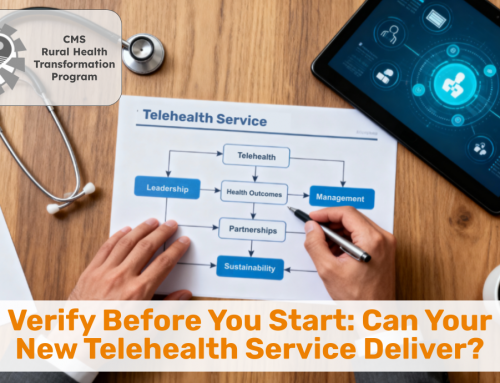This Telehealth Tuesday article was written by Trevor Cunningham, a telehealth consultant on the Ingenium Team.
Over the past few years, I have enabled administrators and compliance managers at a variety of healthcare organizations to craft telehealth policies that are thoughtful, comprehensive, and aligned with long-term strategy.
But even the strongest policy — meticulously worded, neatly formatted, and fully compliant — won’t create real change if it lives only in the proverbial binder on the shelf (or a document on the network drive).
A policy that isn’t operationalized is a policy that’s paralyzed.
Whereas the challenge in 2020 was to cobble together a telehealth policy, nowadays, the most mature healthcare organizations are confronting a new and more urgent challenge: using the telehealth policy to deliver extraordinary care at a distance.
So how do you translate purposefully crafted words on a page into consistent behaviors, reliable workflows, and a culture where virtual care excellence is second nature?
Here’s how leading organizations are doing it — and why operationalizing your telehealth policy is essential to lasting telehealth success.
From Policy to Practice: Why Execution Matters
A policy sets the direction. But it’s operations that move the organization forward.
Without deliberate operationalization, even the most carefully constructed telehealth policy risks becoming obsolete and unused. Teams may revert to old habits. Inconsistencies in virtual care delivery may quietly resurface. Compliance violations may go unnoticed, hidden in the complexity and busyness of daily routines.
Bringing a policy to life requires building a strong connection between the policy’s intent and the daily practice. This means:
- Workflow alignment — designing processes that seamlessly integrate policy elements into daily activities.
- Ongoing training — helping teams not only understand the rules but to embody the standards in real-world contexts.
- Continuous auditing — ensuring real-world practice matches the intended policies, and adjusting when it doesn’t.
- Cultural reinforcement — embedding policy-compliant best practices into the organization’s telehealth DNA.
In other words, operationalizing policy transforms a static document into a living framework that drives quality, consistency, and trust.
Four Key Strategies to Operationalize Your Telehealth Policy
1. Workflow Integration — Policies Should Shape the Way Work Happens
Policies shouldn’t exist as separate checklists that staff must memorize. Instead, they should be woven directly into the design of workflows — shaping how scheduling, documentation, technology use, and clinical decision-making happen organically.
Consider the following examples:
- Scheduling Guides — Embedding modality matrices into scheduling systems to guide visit appropriateness naturally, rather than forcing schedulers to reference a distant manual.
- Smart Phrases — Auto-populating informed consent language into telehealth visit templates, prompting clinicians to meet standards with ease.
- Fallback Protocols — Creating standing order sets or visible job aids for technology failure escalation, ensuring rapid action when systems falter.
If your staff must dig through a PDF to figure out what to do, the policy isn’t operational yet. When workflows naturally guide compliant behavior, the policy moves from theory to practice.
2. Training and Onboarding — Set Expectations Early and Reinforce Often
Orientation to telehealth standards must become an integral part of every new hire’s experience — whether they are clinical, administrative, or IT staff.
In addition, annual refreshers and just-in-time updates ensure the organization evolves with changing technology, regulations, and patient expectations.
Effective training includes:
- Webside Manners Training — Demonstrating professional presence standards through examples, role-play, and video demonstrations.
- Consent Procedures — Practicing verbal consent workflows, not just reading scripts aloud.
- Effective Use of Technology — Teaching not only which devices are appropriate, but why quality equipment matters for patient trust and care equity.
Making training interactive — and connecting it directly to patient impact — helps bridge the gap between knowing the policy and living the policy.
3. Real-Time Auditing and Feedback Loops — What Gets Measured, Gets Maintained
Operationalizing policy isn’t a one-time thing. It’s an ongoing discipline that requires measurement, feedback, and continuous improvement.
To ensure compliance with their policy, leading organizations commit to:
- Clinician Feedback — Actively seeking providers’ insights on what workflows help or hinder them in delivering quality telehealth care.
- Patient Surveys — Asking patients about their virtual visit experiences to surface opportunities for refinement and reinforcement.
- Chart Audits — Routinely reviewing telehealth documentation for appropriateness, consent language, and workflow fidelity.
Importantly, feedback mechanisms are framed not as punitive measures, but as opportunities to support excellence. This often leads to improving the policy, rather than changing the clinicians and staff’s behavior. Transparency, coaching, and collaborative improvements are the hallmarks of a culture where policies stay alive and relevant.



4. Cultural Embedding — When Policy Becomes Part of the Organizational DNA
The ultimate goal is simple but profound: telehealth excellence becomes second nature.
You’ll know your telehealth policy has fully come to life when:
- Staff discuss telehealth norms in daily huddles, without leadership prompts.
- Clinicians self-correct on webside etiquette because professionalism is a point of pride, not a compliance burden.
- Leaders reference telehealth workflows naturally during conversations about quality, equity, patient satisfaction, and organizational growth — not as an isolated or add-on initiative.
Culture is codified through repetition, reinforcement, and role modeling. As telehealth is used on a daily basis, virtual care shifts from an emerging option to an established, readily-available standard.
Bringing It All Together: Policy as a Living Framework
In high-performing organizations, telehealth policy is not something read once and filed away. It’s a living framework — embedded in workflows, reinforced through training, measured through audits, and reflected in the culture.
Operationalizing your telehealth policy isn’t about adding burdens. It’s about removing uncertainty and providing clarity. It’s about making the right behaviors easy, consistent, and sustainable across every department and discipline.
A document in a binder cannot change behavior.
A living, operationalized policy, however, ensures that excellence is not only expected — it is achievable.
Moving from Writing the Policy to Living the Policy
A strong telehealth policy defines what should happen.
Operationalization defines how it actually does.
And leadership defines whether it happens every day.
Where is your organization in the journey from policy writing to policy living? It’s never too late to turn a great document into great care.








To receive articles like these in your Inbox every week, you can subscribe to Christian’s Telehealth Tuesday Newsletter.
Christian Milaster and his team optimize Telehealth Services for health systems and physician practices. Christian is the Founder and President of Ingenium Digital Health Advisors where he and his expert consortium partner with healthcare leaders to enable the delivery of extraordinary care.
Contact Christian by phone or text at 657-464-3648, via email, or video chat.






